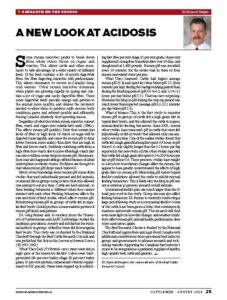A New Look at Acidosis
This article written by Dr. Reynold Bergen, BCRC Science Director, originally appeared in the August 2014 issue of Canadian Cattlemen magazine and is reprinted on the BCRC Blog with permission of the publisher.

Some rumen microbes prefer to break down fiber, while others thrive on sugars and starches. This allows cattle and other ruminants to take advantage of a wide variety of different feeds. If the feed contains a lot of poorly digestible fiber, the fiber digesting microbes will predominate. This allows ruminants to survive in Canada’s long, cold winters. Other rumen microbes dominate when plants are growing rapidly in spring and contain a lot of sugar and easily digestible fiber. These more digestible feeds provide energy and protein to the animal more quickly, and deliver the nutrients needed to allow them to produce milk, recover body condition, grow, and rebreed quickly and efficiently during Canada’s relatively short growing season.
Regardless of what they’re fed, rumen microbes convert fiber, starch and sugars into volatile fatty acids (VFAs). This affects rumen pH (acidity). Diets that contain low levels of fiber or high levels of starch or sugar will be digested more rapidly, and cause the rumen pH to drop lower (become more acidic) than diets that are high in fiber and low in starch. Suddenly switching cattle from a high fiber / low starch diet to a low fiber / high starch diet can cause sudden, severe drops in rumen pH. Rumen acidosis may also happen if cattle go off feed because of a feed interruption or winter storm. Problems are thought to start when rumen pH drops much below 6.
Much of our knowledge about rumen pH comes from studies that used individually penned and fed animals, or animals fed in groups using systems that only allowed one animal to eat at a time. Cattle are herd animals, so their feeding behavior is different when they cannot interact with each other. Feeding behavior affects the rate and level of feed intake, which affects rumen pH. Monitoring rumen pH in groups of cattle fed in regular feed bunks should produce a more realistic picture of rumen pH levels and patterns.
Dr. Greg Penner and co-workers from the University of Saskatchewan and AAFC Lethbridge studied the incidence, prevalence, severity and risk factors for ruminal acidosis in groups of feedlot steers fed from regular feed bunks. This study was co-funded by the National Check-off through the Beef Cattle Research Council, and was published in July’s Journal of Animal Science (92:3053-3063).
What They Did:
278 British-cross steers were fed in 8 pens at the university feedlot. Calves were backgrounded (46% barley silage, 42% barley grain, 13% protein, mineral and vitamin supplement) to 925lbs. Steers were stepped up to a finishing diet (5% silage, 81% grain, 14% supplement) using four transition diets over 19 days, and slaughtered at 1459lbs. Rumen pH was recorded every 10 minutes for the entire trial in three or four rumen cannulated steers per pen.
What They Learned:
Cattle had higher average rumen pH (6.4) and spent less time below pH 5.5 (4 minutes per day) during the backgrounding period than during the finishing period (pH 6.0 to 6.2, and 1.3 to 3.2 hours per day below pH 5.5). That was not surprising. However, the drop in pH during the step-up period was much lower than expected (average pH 6.3, 12.1 minutes per day below pH 5.5).
What it Means:
This is the first study to monitor rumen pH in groups of cattle fed a high grain diet in typical feed bunks, and this allowed the cattle to express normal feedlot feeding behavior. Since 2005, several other studies have measured pH in cattle that were fed individually, or fed in bunks that allowed only one animal to eat at a time. One of the earlier studies found that cattle fed a high grain finishing diet spent 3.9 hours at pH below 5.6, only slightly longer than the 3.2 hours per day reported in this new study. All the other studies reported that cattle fed a high grain diet spent 6.3 to 20.9 hours per day at pH below 5.6. These previous studies have taught us a lot about how dietary changes affect the rumen, but appear to have greatly overestimated the effects of high grain diets on rumen pH. Measuring pH under typical feedlot conditions allowed the cattle to exhibit normal feeding behaviors. This is likely why the drop in pH was not as extreme as previous research would indicate.
Commercial feedlot pens are much larger than the 35 head pens used in this study. Group size may also affect feeding behavior. Dr. Penner is currently conducting a large pen follow-up study at a commercial feedlot. Some of the cattle have been given a bolus that continuously measures and records rumen pH. This research will shed even more light on how diet changes and weather conditions affect rumen pH, animal health, performance, liver scores and carcass grade.
Click here to subscribe to the BCRC Blog and receive email notifications when new content is posted.
The sharing or reprinting of BCRC Blog articles is typically welcome and encouraged, however this article requires permission of the original publisher.
We welcome your questions, comments and suggestions. Contact us directly or generate public discussion by posting your thoughts below.